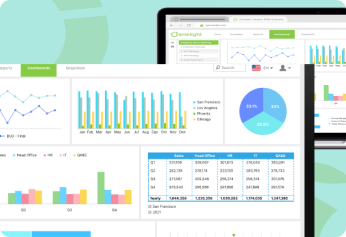Picture this: Your finance team is preparing next year's budget when a supply chain disruption throws your carefully crafted projections into chaos. Sound familiar? This is precisely where scenario planning becomes your strategic lifeline.
Scenario planning is a strategic planning method that organizations use to create flexible long-term plans by analyzing multiple possible future outcomes. Rather than trying to predict one "correct" future, this approach develops several plausible scenarios based on different assumptions about key uncertainties.
Think of it as your organization's way of asking "What if?" across various possibilities. Instead of betting everything on a single forecast, scenario planning helps you prepare for multiple futures, making your strategic decisions more robust and your organization more resilient.
Why Scenario Planning is Important
Finance leaders today face unprecedented uncertainty. Market volatility, regulatory changes, technological disruptions, and global events can derail even the most carefully planned strategies. Here's why scenario planning has become essential:
- Enhanced Risk Management: By exploring different possibilities, you identify potential threats before they materialize. This proactive approach helps you build contingency plans rather than reactive crisis management.
- Improved Decision Quality: When you understand how decisions might play out across various scenarios, you make more informed choices. Your strategic options become clearer, and you can select paths that work well across multiple futures.
- Organizational Agility: Teams that regularly engage in scenario planning develop a mindset that embraces uncertainty rather than fears it. This cultural shift makes your organization more adaptable when change occurs.
- Stakeholder Confidence: Investors, board members, and other stakeholders gain confidence when they see you've considered multiple possibilities and prepared accordingly.
Types of Scenario Planning
Different situations call for different scenario planning approaches. Understanding these types helps you choose the right method for your specific needs:
1. Exploratory Scenarios
These scenarios start with current trends and project them forward to see where they might lead. For example, a retail company might explore what happens if e-commerce growth continues at current rates, accelerates, or slows down.
2. Normative Scenarios
These work backward from a desired future state to understand what conditions would need to exist. A healthcare organization might envision achieving specific patient satisfaction scores and then explore what operational changes would make this possible.
3. Challenge Scenarios
Designed to test the robustness of existing strategies, these scenarios push assumptions to their limits. A manufacturing company might explore extreme commodity price fluctuations to test supply chain resilience.
4. Cross-Impact Scenarios
These examine how different factors influence each other across time. For instance, how demographic changes might affect consumer behavior, which then impacts technology adoption, which influences regulatory responses.
The Scenario Planning Process
Effective scenario planning follows a structured approach. Here's how to implement it:
Step 1: Define the Scope
Start by establishing clear boundaries for your scenario planning exercise. This foundation determines everything that follows.
Time Horizon: Decide how far into the future you're planning. Financial planning might look 1-3 years ahead, while strategic planning could extend 5-10 years.
Geographic Scope: Are you focusing on local, regional, national, or global scenarios? A regional bank faces different uncertainties than a multinational corporation.
Functional Areas: Determine which business areas the scenarios should address. Will you focus solely on financial performance, or include operational, regulatory, and competitive factors?
Key Question: Frame the central question your scenarios should answer. For example: "How might our revenue streams evolve over the next five years given changing customer preferences?"
Step 2: Identify Key Factors and Driving Forces
This step involves detective work to uncover the forces that could shape your future scenarios.
Internal Factors: Consider elements within your organization's control, such as product development capabilities, workforce skills, financial resources, and operational efficiency.
External Factors: Examine forces beyond your direct control, including economic conditions, regulatory changes, technological advances, demographic shifts, and competitive dynamics.
Driving Forces: Look for the underlying trends that influence multiple factors. For example, remote work adoption affects real estate needs, technology investments, workforce management, and customer service delivery.
Uncertainty Assessment: Rank factors by their potential impact and level of uncertainty. High-impact, high-uncertainty factors become the backbone of your scenarios.
Step 3: Develop Scenario Logics and Build Scenarios
Now comes the creative work of constructing coherent, plausible futures.
Scenario Frameworks: Most organizations develop 3-4 scenarios. Common approaches include:
- Optimistic, pessimistic, and most likely
- Growth, stability, and decline
- Status quo, gradual change, and disruption
Internal Consistency: Ensure each scenario tells a coherent story. If you assume rapid economic growth in one scenario, unemployment should be low, consumer confidence high, and business investment strong.
Plausibility Check: Each scenario should be believable, even if unlikely. Avoid both overly optimistic scenarios that ignore real constraints and pessimistic scenarios that assume everything goes wrong simultaneously.
Narrative Development: Create compelling stories that help stakeholders understand and remember each scenario. Use specific details and concrete examples rather than abstract descriptions.
Step 4: Analyze Implications and Options
With scenarios developed, examine what they mean for your organization.
Impact Assessment: For each scenario, analyze effects on key performance indicators such as revenue, costs, cash flow, market share, and operational metrics.
Strategic Options: Identify different strategic responses that would be appropriate for each scenario. Some strategies might work well across multiple scenarios, while others are scenario-specific.
Decision Points: Determine what signals would indicate which scenario is unfolding, and what decisions you'd need to make at each point.
Risk and Opportunity Mapping: Catalog the risks and opportunities each scenario presents, along with potential mitigation or capitalization strategies.
Step 5: Monitor Indicators
Scenario planning isn't a one-time exercise. Establish systems to track which future is emerging.
Leading Indicators: Identify early warning signals that suggest movement toward particular scenarios. These might include economic indicators, regulatory announcements, competitor actions, or technology adoption rates.
Monitoring Systems: Set up regular review processes to assess indicator trends. This might involve monthly dashboards, quarterly reviews, or annual scenario updates.
Trigger Points: Establish specific thresholds that would prompt strategic adjustments. For example, if customer acquisition costs rise above a certain level, you might shift marketing strategies.
Scenario Updates: Plan regular scenario refresh cycles to incorporate new information and changing circumstances.
Scenario Planning in Practice
Real-world applications demonstrate scenario planning's value across industries:
- Healthcare Systems: During the COVID-19 pandemic, hospitals used scenario planning to model patient volumes, staffing needs, and equipment requirements across different infection rate scenarios.
- Energy Companies: Oil and gas companies regularly develop scenarios around commodity prices, regulatory changes, and renewable energy adoption to guide investment decisions.
- Financial Services: Banks use scenario planning for stress testing, exploring how different economic conditions would affect loan portfolios and capital requirements.
- Technology Companies: Software firms develop scenarios around market adoption rates, competitive responses, and technological disruptions to guide product development and market entry strategies.
- Retail Organizations: Retailers explore scenarios around consumer behavior changes, supply chain disruptions, and economic conditions to optimize inventory and expansion plans.
Benefits and Limitations of Scenario Planning
Understanding both strengths and constraints helps you use scenario planning effectively.
Benefits
- Strategic Flexibility: Organizations develop more adaptable strategies that work across multiple futures rather than betting on a single prediction.
- Risk Awareness: Teams identify potential threats earlier and develop appropriate responses before crises occur.
- Improved Communication: Scenarios provide a common language for discussing uncertainty and strategic options across different organizational levels.
- Enhanced Creativity: The process encourages innovative thinking and challenges conventional assumptions about the future.
- Better Resource Allocation: Understanding different possibilities helps prioritize investments and allocate resources more effectively.
Limitations
- Time and Resource Intensive: Quality scenario planning requires significant investment in research, analysis, and stakeholder engagement.
- Potential for Analysis Paralysis: Organizations might become overwhelmed by possibilities and struggle to make decisive choices.
- Subjective Judgments: Scenario development involves assumptions and interpretations that can introduce bias or blind spots.
- Implementation Challenges: Translating scenarios into actionable strategies requires additional planning and organizational commitment.
- False Precision: Teams might treat scenarios as predictions rather than tools for exploring possibilities.
Strengthen Your Financial Planning with Modern Tools
While scenario planning provides the strategic framework for navigating uncertainty, having the right financial planning tools makes all the difference in execution. Many finance teams still rely on spreadsheets for scenario modeling, spending countless hours on manual data consolidation and version control instead of strategic analysis.
Limelight addresses this challenge by providing an intuitive FP&A platform that integrates seamlessly with your existing systems. With pre-built scenario modeling templates and real-time data connectivity, you can spend less time wrestling with spreadsheets and more time developing the strategic insights that drive better decisions.
Ready to see how modern financial planning tools can support your scenario planning efforts? Book a demo to explore how Limelight can elevate your organization’s strategic planning process.
FAQs on Scenario Planning
How many scenarios should we develop?
Most organizations find 3-4 scenarios optimal. Fewer scenarios might miss important possibilities, while more scenarios can become unwieldy and dilute focus.
How often should we update our scenarios?
Annual reviews work for most strategic planning cycles, with quarterly check-ins on key indicators. Major external events might trigger immediate scenario updates.
Who should be involved in scenario planning?
Include diverse perspectives from different functions, levels, and backgrounds. Finance, operations, strategy, and external experts all bring valuable insights.
How detailed should scenarios be?
Balance detail with usability. Scenarios should be specific enough to guide decisions but not so detailed that they become unwieldy or quickly outdated.
Can scenario planning predict the future?
No. Scenario planning explores possibilities rather than making predictions. Its value lies in preparing for multiple futures, not forecasting a single outcome.
How do we avoid bias in scenario development?
Use diverse teams, challenge assumptions explicitly, seek external perspectives, and regularly test scenarios against new information.
What's the difference between scenario planning and forecasting?
Forecasting attempts to predict the most likely future, while scenario planning explores multiple possible futures to improve decision-making under uncertainty.
Table of Contents
Ready to put an end to outdated FP&A?
Get a perzonalized demo


